#Animerama
Explore tagged Tumblr posts
Text
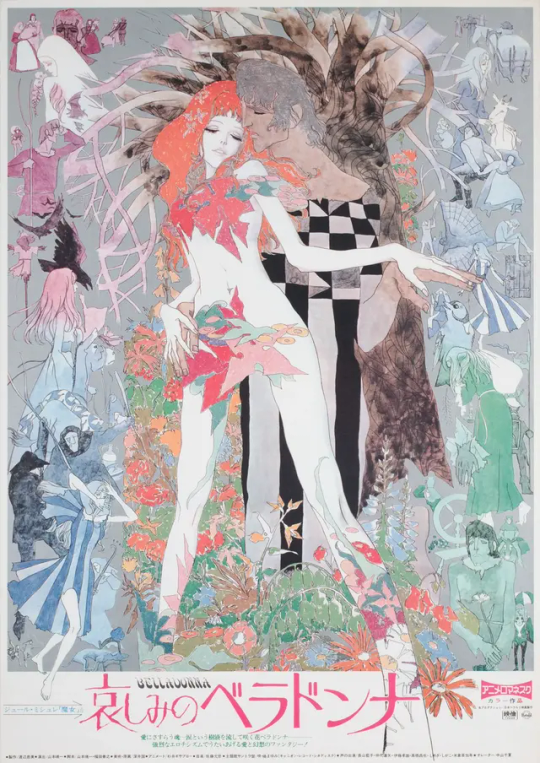
Belladonna of Sadness 哀しみのベラドンナ 1973 Japanese movie poster, version 1
2K notes
·
View notes
Text

Belladonna of Sadness (dir. Eiichi Yamamoto, 1973)
#adult animation#anime#animerama#belladonna of sadness#cinephile#eiichi yamamoto#faust#filmblr#film quotes#i love this movie#jeanne#jules michelet#movie quotes#movie recommendation#mushi production#satanism and witchcraft#witch hunt#yoshiyuki fukuda
8 notes
·
View notes
Text
My copy of Belladonna of Sadness came in, which means this weekend is the Animerama marathon!
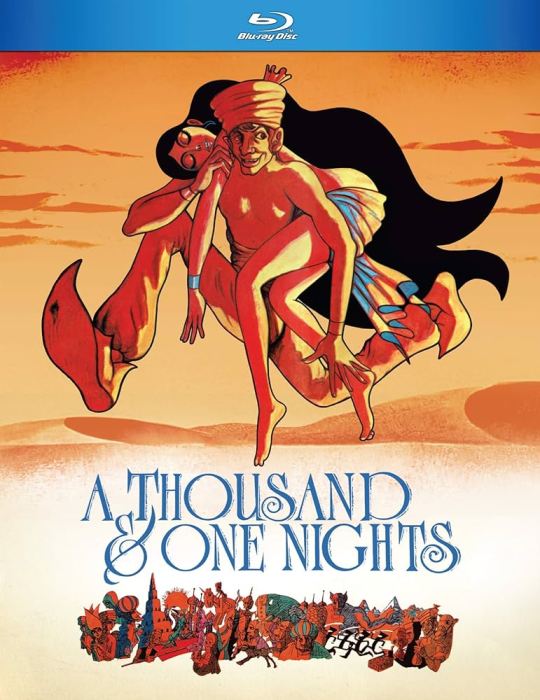


Looking forward to becoming Cultured™
11 notes
·
View notes
Text
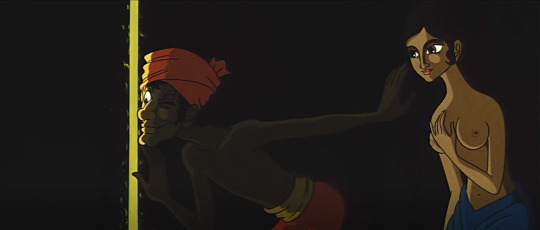
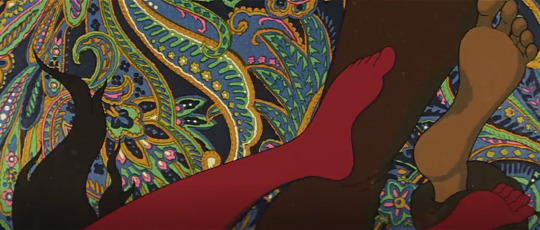
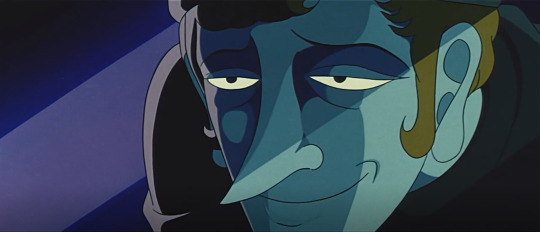
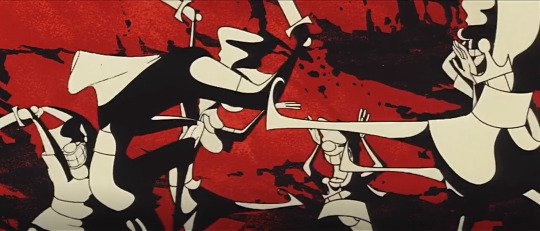

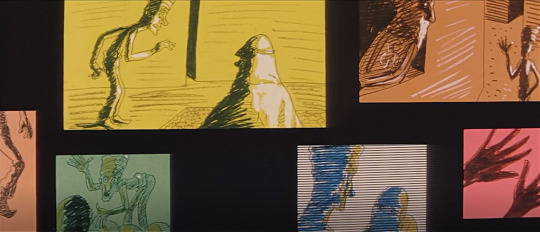
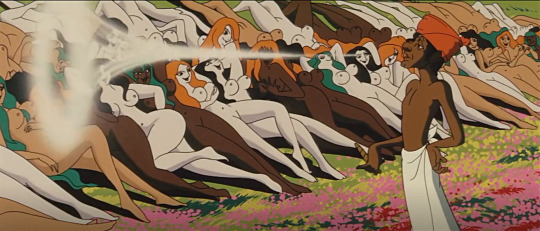

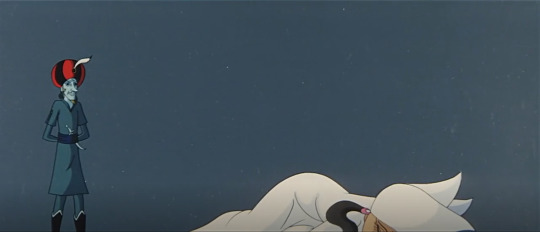
千夜一夜物語, A Thousand and One Nights (1969). Directed by Eiichi Yamamoto.
4 notes
·
View notes
Text
Is it Me or do these Characters from the 70s


Look like these Characters from the 80s?


#ok I know that TLU came out BEFORE BOS but it did got adapted into a film decades after the last animerama movie#indie text#non disney#belladonna of sadness#the last unicorn
137 notes
·
View notes
Text

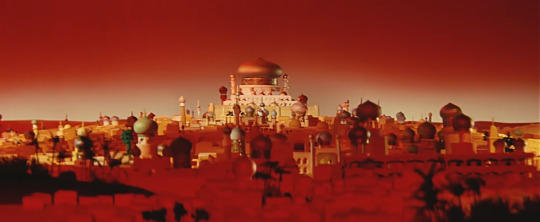
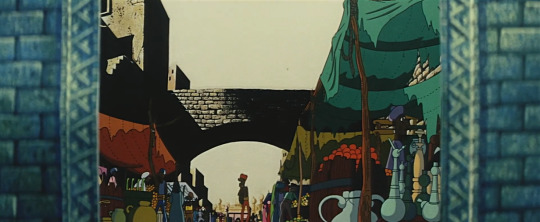
#:1001 Nights#openings shots... again with a lot of experimentation. I can't say I don't like that element#of the animerama trilogy
6 notes
·
View notes
Text
Season 3 Ramble #8 - A is for Anime(solo reprise) ver.3
Hadn't been doing the run-up posting I usually do for my rambles due to work and such but here we are!
How this ramble is gonna go is I'm gonna list my top 3 movies watched this month then top 3 series for same, AAnd now that I actually have a semi decent number of anime under my belt I'm gonna do a quick top ten of both at the end.. after that if you wanna stick around, instead of the usual post ramble ramble, I'm gonna add a bit of the recording I did with the homies, as a sort of prelude and promise that we will have that conversation in future. I really think it's an important and potentially fruitful discussion to have.
But In any case getting into the episode now
TOP 3 MOVIES
3) Belladonna Of Sadness (1973, 1hr33m, Mushi Production)
Crazy movie. I don't think I can accurately talk about it without it sounding too wHild… I'm still gonna, but I'm gonna open with what Google says about it.
A peasant woman is raped by the local lord on her wedding night. To take revenge, she makes a pact with the Devil himself who appears as an erotic sprite and transforms her into a black-robed vision of madness and desire.
As I said.. wHild… and that's just the summary…the details of the actual movie are like…woah.. but in any case it was great, actually something that'd been on my watch list for a good long while so I'm glad I could actually finally watch it.

Glazing over the plot which the summary does a pretty good job of covering anyways, the visuals were absolutely stunning. They're by Yoshitaka Amano, probably most famously known for his final fantasy illustrations. For the most part the visuals are done in what looks like watercolor paint, which is just wild in my mind,, like wHy?? He definitely pulled it off though which is even more crazy cause a good amount of it was done in an almost slideshow kinda way which I usually don't like but he still pulled it off…crazy…. Should be kinda obvious from the summary but moderate tw. Still definitely strongly recommend.
Small sidenote - in making this ramble I found out that belladonna of sadness is actually part of a trilogy called animerama,, so now I have 2 more old ass movies to look forward to. Hopefully they're just as good or even better…
2) Lupin IIIrd: The Gravestone of Daisuke Jigen (2014, 51m, Telecom Animation Film)
Ever since I watched my first lupin movie 3 years ago I've been locked in. In fact it was such a good watch that I've limited myself to one a year. Thankfully the trend of awesomeness has continued up to this point but enough premature glazing.
This movie is basically centered on Jigen, as you can probably tell from the title. Just a point of clarity for those who don't know much of anything about lupin, Jigen is basically the gunslinger of Lupin’s crew. So as this is basically his movie, he's ofc facing off against a gunslinger. The title is so named because this guy, the gunslinger they find themselves up against, makes graves for his victims before killing them. Nobody's ever gotten away from him. In fact he's so good that he uses dice to decide how many bullets he'll use to take out his target. Ice cold mf.

Pretty good action from start to finish though I’m a tad disappointed there wasn't more gun-slinging, though from what I gather Jigen’s whole thing is speed, accuracy and efficiency,, so maybe a barrage of bullets wouldn't have made sense. In any case we get to see all of the crew besides goemon, dry cry as he's my personal fav but still solid. The art direction was great from all angles as I've come to expect. Not too much to say cast wise as on Lupin gang’s side there's a cumulative effect of greatness where every time you see them it's generally a continuation of past interactions, as in there's an obviously rich history there. That being said, the dynamic is still great and from what I've seen, you can pick up any of the movies and immediately love them. But anyways, on the other hand, the main villain/organization felt a bit hollow. Which is something I've come to kind of expect with movie exclusive antagonists in general. It's just a matter of time efficiency. I think when it comes to anime movies, you're generally not watching for the antagonist unless they have to do with the main storyline. Otherwise you're kinda watching to see how the protagonist will beat them in about an hour. Though I will say as far as visuals can speak, they definitely spoke volumes in that sense. Also, given the geopolitical climate we're in, I liked the villain/organization and how they were handled... trying not to spoil too much there but if you so much as peek between the lines you probably get it.. In any case definitely highly recommend.

Side note - every lupin movie I watch further solidifies my decision to get into the series… just watching the movies first for some reason…
1) Mind game (2004, 1hr44m, Studio 4°C)
Honestly,, I don't even want to speak on it for fear of sullying its greatness. It's one of those life changing before and after watches fr. This is something I'd been really wanting to watch since ver.1 when I started getting into Studio 4°C through their awesome anthologies genius party and genius party beyond.
I'm gonna default to the anilist description here which is kinda almost decent relative to the sheer phenomenal amazingness of this movie.. but I digress.. so according to anilist..

Audiences will begin to grasp what they are in for early on, as loser Nishi, too wimpy to try to save his childhood sweetheart from gangsters, is shot in the butt by a soccer-playing psychopath, projecting Nishi into the afterlife. In this limbo, God - shown as a series of rapidly changing characters - tells him to walk toward the light. But Nishi runs like hell in the other direction and returns to Earth a changed man, driven to live each moment to the fullest.
The last bit hints at the greatness of this film. Right there that small difference in speech speaks volumes in my personal world of language. It's not just a movie. It's film. 10/10. absolute cinema.

As I said I don't even want to talk about it too much because I don't think it possible to do it justice through mere words, but I'm gonna put a bit more glaze on it before I wrap up the movie list and move on to series. This movie beat out studio ghibli’s, Miyazaki directed, howl’s moving castle in the 2004 Japan Media Arts Festival. Further, this was a debut work for the director Masaaki Yuasa, who would later go on to found science saru studio. I was so moved by this movie that I've decided I will watch everything masaaki yuasa has and will ever direct. 10/10. highly recommend. end of glaze.
hm: under the dog, Mezzo forte, blood: the last vampire, 4°c (sweat punch, short peace from last time)
Top 3 Series
3) Frieren: Beyond Journey's End (2023-2024, 28ep 24m, Madhouse)
This is something I'd been seeing around for a bit but was intentionally ignoring because for some reason I got it in my head that it was based on this sad little one shot called The hero’s party on their way back home, and I was NOT watching an entire series based on that.
In any case, in talking with my bros recently they all insisted that it was the best anime released in the past year, one of them declaring it was in his top5 all time. So I pushed past my fears and binged it all in a day. V thankful for the bros.
The story here follows an elven mage called frieren and her life after defeating the Demon King and bringing peace to the world.

As you can tell from the summary it's largely a slice of life but it has its fair share of well placed scraps. It fills a certain fantasy gap where you get that day to day rose tinted indigenous peoples’ lifestyle feel, that I think most people would want if they actually lived in a fantasy setting,, not that constantly under threat from dragons and shit usually focused on. And as I said there are some well placed fights. The pacing also felt perfect. Like I almost felt bad binging it because I could tell that once a week watch would've been REALLY good… one of the few series I don't want to read the manga for, I'll definitely be watching weekly whenever season 2 drops..
Great cast though kinda small, pretty brilliant visuals and sound direction. Very very very solid all round, what I'd call supremely balanced tbh. One of the bros put it really well in that he said he has synesthesia so everything has colours for him, and the colours of every aspect of this show came together to paint the perfect picture. Now I don't have synesthesia myself but I could definitely feel, not just see, how well orchestrated it all was. definitely strongly recommend.
2) Tengen Toppa Gurren Lagann (2007, 27ep 24m, Gainax)
Yes. It's 2024 and I’m just watching gurren lagann and you'll hear why that is if you listen in to the post ramble ramble,, but suffice to say, you can never be late to true greatness and Tengen Toppa Gurren Lagann is definitely in that category.

Firstly I kinda watched it as a meme seeing as last ramble I focused on the supposed relationship between sacred geometry and JoJo's bizarre adventure… if that sounds crazy then you should listen to the ramble… not that it'll sound less crazy but..yh.. anyways I was vaguely aware that gurren lagann focused a bit on spirals so I tapped in for the meme.
To summarize the lengthy anilist summary,, In a far away future, mankind lives underground in huge caves, unknowing of a world above with a sky and stars. yada yada yada blah blah blah Simon, Kamina, Yoko, and the small yet sturdy robot, Lagann, journey to the world above and find that the surface is a harsh battlefield, and it's up to them to fight back against the rampaging Beastmen. Pierce the heavens, Gurren Lagann!

Again I'm gonna fall back on the words of another of my bros from the session, I think he had it in his top 10 or 5,, but he said he considers gurren lagann to be a perfect starter anime in that it perfectly showcases almost everything the medium of anime has to offer. Action, comedy, philosophy, slice of life, amazing cast, brilliant visual direction, solid sound direction. etc. the term “starter anime” gets thrown around a fair bit and I usually think it's a rubbish term because of how insanely diverse the medium is and how specific different individuals tastes can be,, so like to say this or that anime is a good “starter anime" never made sense.. but when he said it, that was the very first time I actually thought it made sense..
Definitely super highly recommend, a recommendation to pierce the heavens if you will.
1) Akiba Maid War (2022, 12ep 24m, P.A Works)
Gotta say it was a tough call between this and gurren lagann but it won out for 3 reasons. #1 it's shorter, and that's not a lazy pov, I just personally tend to give more ratings to shorter series in general because I think being able to do something amazing in a short amount of time deserves more props than doing so in a longer span of time. personally.. #2 it was FUNNY. AS. FUCK. I'm coming to realize that when it comes to anime specifically, comedy may be my favourite genre. I can't quite put my finger on why but I think it has to do with how far animation as a medium can push physical humor.. idk.. lastly… idek why I felt the need to justify all this…it's my list… but lastly,, and most importantly. maids. enough said..

The story here follows the dealings of different maid cafes in the town of Akihabara. I say dealings because in this show the maids basically act like Yakuza, having turf wars, extortion rackets and drug trades(just a point of clarity for those who've never heard the term, you've probably guessed but Yakuza are basically Japanese gangsters). In any case this is all under the table as they pay off the police and act the usual cutesy part in front of civilians. That may be a bit of a spoiler but a gif of it was going around a lot last year i think,, with this one maid gunning down a bunch of other maids and it was made to look like an idol rave with the glow sticks and everything + the “twist" if you can even call it that happens in episode 1 so it's not like some major turning point spoilers + "wars” is literally in the title, so with all due respect, you can bite me..

In any case, as I said this shit was funny ASF, mainly because of the opposing imagery of maids and yakuza they somehow pulled off perfectly.. like I can't begin to explain how crazy it is to see maids cussing each other out with the most obscene language, fighting it out in the craziest brawls, then turning around and going “welcome home master”.
Fairly small but very strong cast, all funny in their own unique ways from the hardened criminal type to the frightened newbie. the visuals were great, sounds direction solid, I really really loved the op and ed, cause they just perfectly matched the shows energy. Kinda episodic for the most part but that fit the crazy, “you'll never guess what happens next” energy… Just great overall like wow.. a bit surprised I haven't seen it around more but I realize comedies don't tend to get that much ratings on release, if they do get attention it's further down the line as a “hidden jewel".
But in any case yes. 10/10. definitely highly recommend. please go watch this. have a good laugh, give thanks for life and go see the beauty of the world.
hm: Flying Trapeze, Goodbye Mr. despair (from s2)
Top 10 Movies (no order)
A Silent Voice, Memories (anthology directed by katsuhiro otomo), One Piece Movie 6: Flower Island, Tokyo Godfathers, Mind Game, Ocean Waves, Nausicaa Of The Valley Of The Wind, Sword Of The Stranger, the Lupin movies (just watch all of them lol), Maquia: When The Promised Flower Blooms
hm: Words Bubble Up Like Soda Pop, Animatrix, GITS Innocence, Wolf Children, Princess Mononoke
Top 10 Series (no order)
Tengen Toppa Gurren Lagann, Akiba Maid Wars, Nichijou, Hyouka, Mononoke, Sonny Boy, Tatami Galaxy(all spinoffs, movies, everything.), Steins;Gate, Dorohedoro, Angel Beats, Durarara!!(all seasons)
hm: Baccano!, Pluto, FLCL up to Progressive, Cowboy Bebop, chainsaw man
#just another day#mm..manga#writeup#belladonna of sadness#lupin IIIrd: the gravestone of daisuke jigen#mind game#frieren: beyond journey's end#tengen toppa gurren lagan#akiba maid war
9 notes
·
View notes
Text
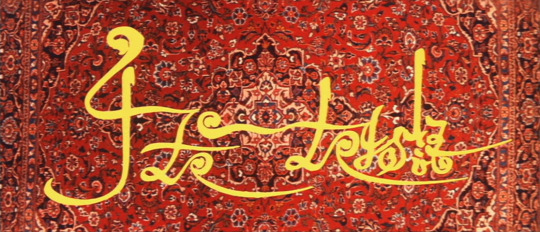
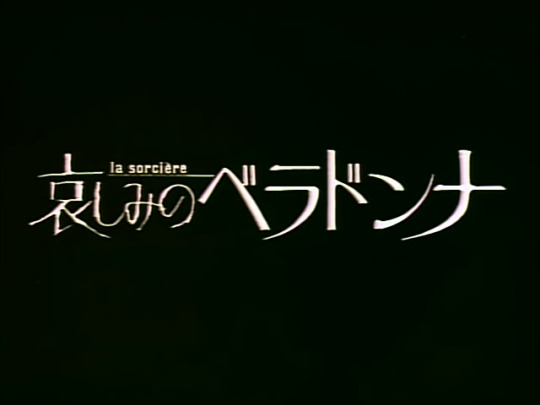
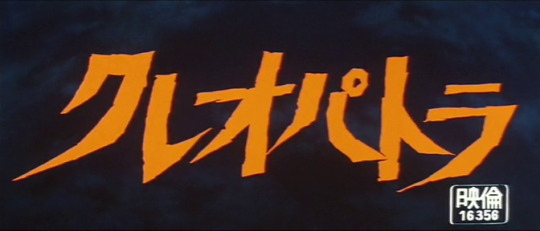
Now here are some real gems. The World Master Piece Theater titles i've been picking out of the pile might be classics but they were all fairly safe and stable works both artistically, financially, and culturally. But MushiPro's ANIMERAMA film trilogy were boldly ambitious, bordering on avante garde, and delightfully irreverently bizarre. They didn't tend to do great at the box offices but coasted by on the power of Osamu Tezuka's reputation.
1001 Nights, the first of the three, actually performed fairly well and even earns itself a little historical footnote as one of the world's earliest feature length animated erotica. Its English dub even beat Ralph Bakshi's infamous Fritz the Cat to theaters by a couple of years, although it's impact on a US market was nearly nonexistant.
Belladonna of Sadness has had an odd resurgence in cult classic status as of the past few years for some odd reason. It sports a very brash 70s brand of feminism and sexual liberation in addition to its erotica and psychidelic themes. It draws from the 1862 "historical" text, La Sorcière. It was notable for being a record of the "history" of witchcraft in Europe, but one with a relatively sympathetic view of pagan rebelliousness against the catholic church. It's also drawing from those themes of rebellion as innate to witchcraft that the movie plays with themes of the French Revolution and 2nd wave feminism. It was a financial flop but has endured as a cult classic.
Less favorable to box office number and critics alike was Cleopatra. Other than some bad advertising/marketing it had a weird mix of styles, including bits of rotoscoped animation, and walked an odd line in being raunchy but not actually pornographic, which resulted in aforementioned muddled advertising efforts. It's also just kind of a jumble of a plot about time travelers going back in time to stop aliens from masquerading as Cleopatra and seducing the great leaders of the ancient world and rewriting the history of humanity.
3 notes
·
View notes
Text
the Animerama trilogy is... interesting. clearly, the stumbling block the first two films experienced was a rather shallow conception of what an animated film for adults could be. rather than try and craft mature, thoughtful stories with grounded, complex, and relatable themes, they simply went with the teenage boy's answer of, "mature stories are when there is sex and violence and most importantly sexual violence." Cleopatra improves on A Thousand and One Nights by having a plot, but cannot seem to tear itself away from the childishly bawdy jokes and rather hit-or-miss referential humor which ultimately slow the pace way down in the back half.
as pieces of animation history, they hold up, however. eiichi yamamoto is a brilliant director and masterful surrealist. despite his and osamu tezuka's rather clear and unchecked misogyny in the erotic depictions of women in these films, every sexual sequence is inventive, wildly expressive, and fun to watch. i particularly enjoyed the ways they worm around the censors by vaguely implying the appearance of genitalia in certain abstract sequences in a plausibly deniable way. good job there, lads.
the standout of the trilogy, though, is Belladonna of Sadness. unlike the first two films, this is an actual movie with a fully coherent and realized plot with themes and motifs and things to actually say. as a loose adaptation of historical accounts of medieval european witch trials, it sets itself apart from the first two movies as being stridently proto-feminst. while the constant nudity of the protagonist and the way the film chooses to portray the sexual violence levied against her is as distasteful and exploitative as it was in yamamoto's previous efforts, it manages to stick the landing in the end.
it is the sympathetic story of a young woman seeking a better life for her and her new husband after she had been horrifically raped by the local lord's court on her wedding night. unfortunately for her, she is tricked into making a deal with the devil for that better life and misfortune after misfortune befalls her as her husband does not love her and the social status and wealth that she sacrificed to give him go to waste as he drinks himself stupid and lies in bed all day. at every turn, she is exploited, abused, and manipulated by the men in her life, including the devil. but in the end, she gets her revenge, even beyond the grave in a way that no one could have imagined.
Belladonna of Sadness is not a perfect movie. it's beautiful, evocative, deeply surreal, and smartly written, but i would hesitate to call it necessarily progressive. for the early 70s, perhaps it was groundbreaking, but by modern standards, it has lost some luster on that front. i still highly recommend it, however, with the stated caveats in mind. if you choose to watch a single film from the Animerama trilogy, make it Belladonna because the other two will only disappoint and bore you more often than not, unless you are off your goddamn tits while watching them.
#no hate to osamu tezuka but i'm kinda glad he dropped out of Belladonna's production in the early stages#i feel like his somewhat childish storytelling sensibilities were holding yamamoto back in the first two films#dude wrote some of the most foundational manga of the 20th century but those were all written with a very young audience in mind#and you can kinda see him straining to break those habits and failing in the first two films#maybe he got better at screenwriting at some point but frankly this has left a bad taste in my mouth for his work in animation
0 notes
Text

Belladonna of Sadness 哀しみのベラドンナ 1973 movie poster, version 2
36 notes
·
View notes
Photo

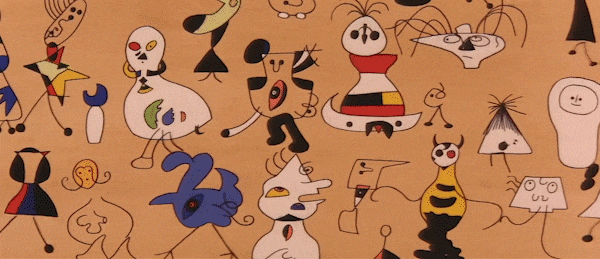
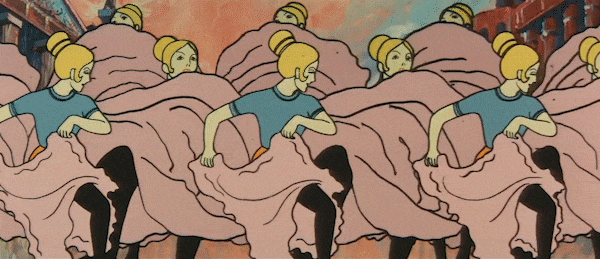
Cleopatra: Queen of Sex . Osamu Tezuka & Eiichi Yamamoto . 1970
#Cleopatra#Osamu Tezuka#eiichi yamamoto#1970#anime gif#Animerama#painting#fine art#hieronymus bosch#picasso#joan miró
1K notes
·
View notes
Text
Belladonna of sadness (1973)
This is the last of Tezuka's animerama trilogy and it was a hard watch. This movie goes over heavy and triggering content so be warned. Jeane is viciously gang r@ped by the Lord of the kingdom and his generals on the day of her wedding. Traumatised and frustrated from what happened, she decides to make a deal with the devil to take revenge on the system.
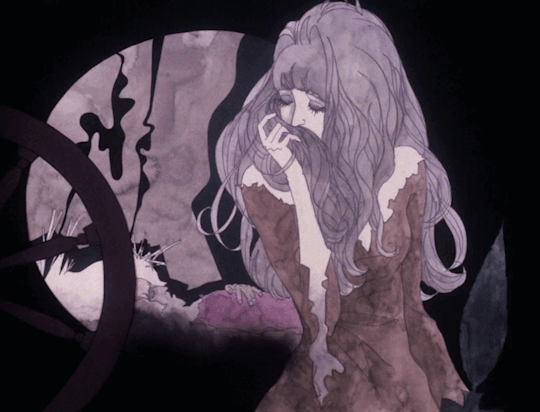
My opinion might be a tad clouded from personal experiences but I got some gripes with the plot. Jeane is only given agency when she gives herself to the devil (who is shaped like a dick btw). So it's like Jeane is strong and defined by her trauma which is a big ol yikes. It feels like the film is trying to arouse the audience at any chance it gets. The nudity, violence and especially the r@pe scenes feel like their designed to be erotic from the way they draw Jeane in these compromising positions. Safe to say that watching this made me uncomfortable. The r@pe scene at the beginning made me disassociate so while my mind's a little fuzzy for that bit it must have been graphic to do that.
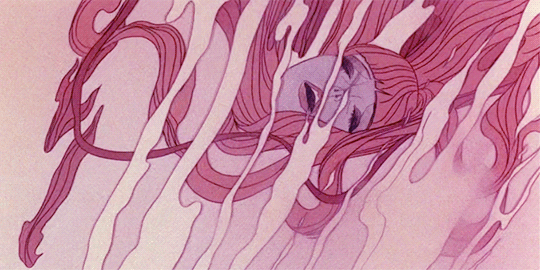
The illustrations are absolutely gorgeous with lovely watercolour art and changes medium every now and then. Animation isn't too common so more often than not the movie uses stills. When it is animated it's smooth and nice to at (out of context at least).
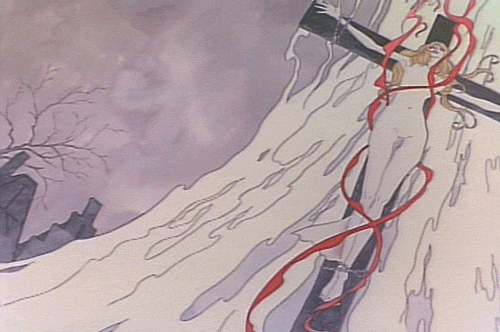
Belladonna of sadness left a bad taste in my mouth, it's such a shame since the art is so beautiful. I think the story could have worked with tweaking but as it is now it isn't something I'd recommend. I'd say to just Google the art and watch some other movie that handles these topics better. Promising young woman is supposed to be good so that might be a good substitute.
The list
#animated movies#animation#every animated movie#animation history#movies#film#old movies#1970s movies#1970s#70s films#70s#1973#japanese animation#anime movie#animerama#anime#osamu tezuka#belladonna of sadness
8 notes
·
View notes
Link
6 notes
·
View notes
Text
Rest in peace, Eiichi Yamamoto.

4 notes
·
View notes
Text
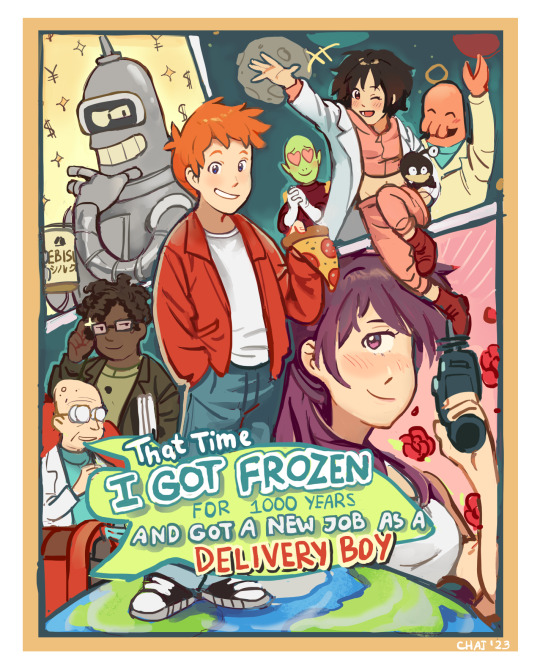
okay so we all agree that futurama is an isekai but what about an overly long and dumb title?
(clean version under the cut)

this is gonna be my legacy... i tried being faithful to the Typical Anime Style but got carried away lol
#futurama#animerama if you will....#i hate doing high quality shitposts lmao#philip j fry#turanga leela#bender bending rodriguez#bender#hermes conrad#amy wong#zoidberg#kif kroker#hubert farnsworth#damn thats a lot of tags
26K notes
·
View notes
Text
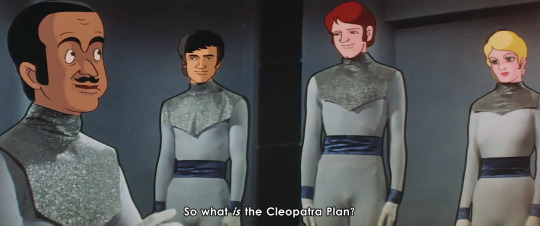
Upon finishing Cleopatra: Queen of Sex, I am left with one simple, rather frustrating question to have at the end of any movie: What was the point?
I can’t help but compare it to Belladonna of Sadness, the film following this one in the Animerama trilogy, and lament Cleopatra’s apparent lack of purpose or narrative vision. Because while Belladonna of Sadness is quite a troubling movie to me personally – I simply cannot call it feminist, and I find it harder and harder to not just admit it is really, very misogynistic despite Eichii Yamamoto’s attempts to grapple with feminist ideas therein – I cannot say it wasn’t trying to impart a meaning, or even that it didn’t succeed in doing so. It was very squarely, definitely, about something. I came away from Belladonna of Sadness shocked, sad, and sympathetic – even if that sympathy was and is still conflicted.
On the other hand, Cleopatra: Queen of Sex left me puzzled and somewhat disgusted, and I don’t even think it was on purpose. And yes, I’m a 28 year-old harpy woman feminist whatever, of course I took umbrage with a 70s cinemax porno anime movie, what did I expect? But that really didn’t even turn out to be my main complaint. In fact, that didn’t even make it into the Top 3 problems I have with this movie, which are as follows:
3. Cleopatra, kind of like Jeanne now that I think about, didn’t actually have much agency and just sort of reacted to the story unfolding around her, despite being the main character. This is exacerbated by having her actions be controlled by another, much more wicked older woman throughout who is doing all of the planning for her.
2. The time-travel framing narrative was completely nonsensical, unnecessary, and went ignored for the vast majority of the movie.
and 1. The ending of the framing time-travel narrative is in complete opposition with the preceding 1 hour and 40 minutes of the story.
Now, I said that the time-travel framing narrative went ignored in the majority of the movie, but that isn’t technically true. If you must know, the time-travellers passively sitting inside of the brains of the ancient people – and a leopard – did contribute One thing to the story throughout: raunchy, absurdist humour. The man inside of Cleopatra’s pet leopard seemingly kept his consciousness somehow, since he was a perverse dunce that facilitated bestiality jokes, just as he did before he got stuck inside the body of an ancient leopard. What a blessing. Thank you Tezuka, for showing me various images of a wacky cartoon leopard trying to have sex with human women.
The other time-travellers ended up in the bodies of humans, a roman slave and a young woman who was a close friend of Cleopatra’s. They, for some unexplained reason, were not consciously controlling the bodies they are inside of, nor were they able to investigate anything despite that being the main conceit of this journey. The roman slave is able to craft explosives and, ridiculously, a handgun, but he has no idea how he knows how to do these things or why he is compelled to. He says vaguely, “someone in my heart is telling me how to do this” and “I made this on impulse, I have no idea how it works”. The young woman does not feel any similar impulse or have access to hidden future knowledge – she may as well have never been possessed at all. Her life goes on exactly as we would assume it would had she not been.
All of the things these three characters do, whether they had been possessed by time-travellers who do nothing anyway or not, could have simply not been done at all and nothing in the story would be very different. History would have played out the same way regardless if the roman slave won his coliseum battle by shooting his opponent with a handgun, and other similar absurdities. Cleopatra steals that handgun afterwards and threatens to kill Calpurnia with it for stealing away Caesar, but Calpurnia convinces her otherwise by showing her that Caesar doesn’t love her, so Cleopatra doesn’t even end up using the gun to change the outcome of history. And need I even explain how whether or not the leopard wants to hump various women doesn’t matter at all, beyond facilitating crude humour, the same way the imagery of a roman slave holding a glock facilitates absurdist humour in this movie?
And it was still not necessary to include them even for the sake of just facilitating humour. There are tons of elements in this movie that are purposely “out of time and place” for the sake of absurdity. All the montages of fine art parodies from around the world, the scene of the various famous statues that have Caesar’s likeness forced onto them after he becomes emperor, Caesar’s assassination playing out like a Japanese stage play. Caesar literally returns to Rome with Cleopatra in a red sports car. This movie never claimed to be aiming for any sort of historical accuracy – we even got a disclaimer about that right off the hop! – we didn’t need any reason for the roman slave to be able to craft a gun, or for the leopard to be horned out of his mind, or the girl to do… nothing…
Functionally the only thing the time-travel framing narrative did was render this movie meaningless in the end. The reason the time-travellers went to the past was to figure out why an alien race on an alien planet called Pasateli, which Earth is trying to conquer, have named their plans for rebellion against Earth “The Cleopatra Plan”. They watch the real Cleopatra’s life unfold in ancient Egypt, and return to the future saying that they now understand what the “The Cleopatra Plan” might be.
The aliens of Pasateli have been sending beautiful women to Earth to seduce the earth men and then, when they are vulnerable, kill them. Upon discovering this, earth launches missiles to Pasateli to destroy it, and the movie ends.
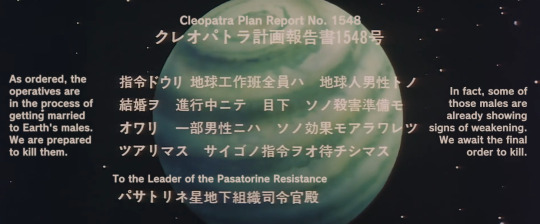
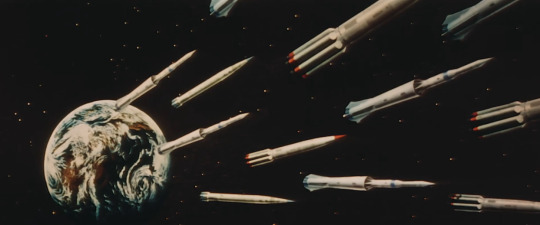
But Cleopatra was not a conniving, wicked woman trying to destroy mankind – this movie does not present her as such. She was being guided and pressured by Apollodoria, and even so, she resisted her demands and fell in love with both of the Roman leaders she had been tasked with assassinating. For an hour and 40 minutes we watch this story about this poor woman who cannot bear to kill the men she loves, not even for her beloved Egypt. Even when Caesar betrays her love, she does not plot revenge or kill him where he lay – she runs away in sorrow. And after Antony dies in his battle against Octavian, helped by Apollodoria’s meddling and poisoning, Cleopatra tries to run away and live in solitude, saying she wants to go back to the way she was before and live a normal life. But Octavian chases her down, helped by the vengeful Apollodoria, and Cleopatra dies when her desperate final attempt to assimilate with the Romans for the sake of survival fails against Octavian, who is immune to her charms because he is gay. (And by the way, in this mess of a story, what is that supposed to mean?)
Similarly, the Egyptians of the movie were clear victims, analogous with the aliens of Pasateli whom Earth was trying to conquer. After Cleopatra committed suicide, faced with being captured and executed by Octavian and having no choice but to do so, the young Egyptian woman one of the time-travellers ended up inside of screamed and cried and begged for the Romans to leave Egypt. That is how the story that takes place in ancient Egypt ends, with an Egyptian woman begging for the conquerors to leave them alone. And then we hard cut to the future and the time-travellers just glibly say, Oh, the Pasateli are trying to destroy us by seducing our men, just like Cleopatra did! Even though in this story, she didn’t.
It is awful. It is insanely misogynistic. It is weirdly conspiratorially racist and brings to mind the bogus “great replacement” theory that neo-nazis insist is definitely real and happening (it isn’t). It makes no sense.

I could try to spin it differently, and try to make a bold claim that this movie is actually about how humans never learn anything from history. How else can you justify none of the time-travellers, particularly the woman who had resided inside of the mourning Egyptian, not pausing and asking: Wait, are we the baddies? Are we the Roman conquerors that drove the titular Cleopatra to desperate measures and an early demise? Are we the villains incapable of witnessing and understanding the violence we are perpetuating even when it is staring us directly in the face?
But that’s a hard sell and one I cannot actually endorse, because this movie did nothing to earn that interpretation beyond have bafflingly bad writing that forces you try to make sense of it. And because there is a comedy scene wherein Egyptian women band together and plot to exhaust the Roman soldiers in Antony’s army with sex prior to his battle with Octavian’s army, ensuring he loses. And it works.
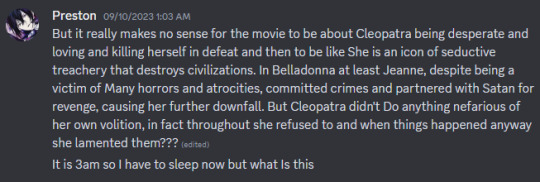
So was this time-travel framing narrative worth witnessing for the sake of laughing at the horrendously rotoscoped anime heads atop live-action actors in a kitschy sci-fi lab? Not in my opinion, no, even though I do love to see animators experiment and I do love feeling like I’m going insane sometimes. And while I can appreciate the artistry of this movie – and there is a lot of it to enjoy! – I have a big problem when a story like this is so contradictory. And no, it being an experimental adult movie from the 70’s doesn’t absolve it of having bad, confusing writing and being dissatisfying.
4/10 for some compelling visuals and a lot of experimental animation that kept things fresh, but it was majorly dragged down by a story that was a little too careless to just be dumb entertainment.
#:Cleopatra#cleopatra 1970#cleopatra: queen of sex#Octavian did slay the entire house down every time he was on screen but alas. He could not save this movie#readmore because I ended up typing 1673 words about this -_-
3 notes
·
View notes